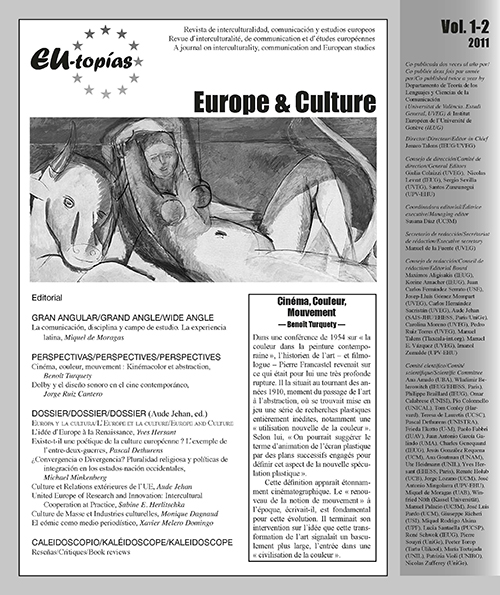The comic as a journalistic media
DOI:
https://doi.org/10.7203/eutopias.1.18446Keywords:
Journalism, comic, communication, information, media, graphic journalism, documentary Abstract
Abstract
Non-fiction is one of the newest current ways of expression of the the comic, and within, the secuential narrative with imported codes of jour- nalism. From increased production and diversity of these hybrids, deri- ves a theoretical conflict: the existence of new forms of communication that go beyond the conceptual boundaries of Journalism. This article focuses on the historical sequence that has contributed to this marriage, exposes to critical review the journalistic dimension of the products, and defines the characteristics of so-called «comic-journalism».
 Downloads
Downloads
 References
References
ABREU, Carlos (2000). “ La imagen periodística no fotográfica (II) El dibujo: definiciones y orígenes”. En, Revista Latina de Comunicación Social, 29, http://www.ull.es/publicaciones/latina/aa2000rmy/104abreu2.html
ARCHER, Dan (2009). «The Honduran Coup. A Graphic History». En http://archcomix.chipin.com/the-honduran-coup-a-graphic-history-32p-comic
ARTIGAS, Jordi (2005). “Josep Lluís Pellicer (1842-1901), corresponsal de guerra, antecessor dels repòrters fotogràfics actuals”. En Treballs de Comunicació, Sept. 2005. Núm. 19, pp. 67-87.
BARBIERI, Daniele (1998). Los lenguajes del cómic Barcelona, Paidós.
BARNOUW, Erik (1996). El documental. Historia y estilo. Barcelona, Gedisa.
BARRERO, Manuel (2005). 2007) “La novela gráfica. Perversión genérica de una etiqueta editorial”. En http://www.literaturas.com/v010/sec0712/suplemento/articulo8diciembre.html
BASTIDA, Maria Dolores (1989). “José Luis Pellicer, corresponsal artístico en la última guerra carlista”. En Espacio, Tiempo y Forma, Serie VII, Hª del Arte, pp. 343-376.
BERNAL, Sebastiá & CHILLÓN, Luís Albert (1985). Periodismo informativo de creación. Barcelona, Mitre.
BORRAT, Héctor (1989). El periódico, actor político. Barcelona, Gustavo Gili.
BRESCHAND, Jean (2004). El documental. La otra cara del cine. Barcelona, Paidós.
CHAVES, Marta y SERRANO, José A. (2002) “Palestina, de Joe Sacco”. En http://www.guiadelcomic.com/comics/palestina.htm
CHILLÓN, Albert (1999). Literatura y periodismo. Una tradición de relaciones promiscuas. Barcelona, Universitat Autònoma de Barcelona (UAB).
COOKE, Rachel (2009). “Eyeless in Gaza”. En The Observer, The Guardian, 22 de noviembre.
COCKBURN, Patrick (2009) “They Planted Hatred in Our Hearts”. En The New York Times, 24 de diciembre.
ECO, Umberto (1973). Apocalípticos e integrados. Barcelona, Lumen.
EISNER, Will (1985). Comics and Sequential Art. Florida, Poorhouse Press.
GARCÍA, Sergio (2010) La novela gráfica. Bilbao, Astiberri.
GARGIA PRIETO, Mónica (2010). “Notas al pie en Gaza, mucho más que un cómic”. En http://www.elmundo.es/blogs/elmundo/orienteproximo/2010/02/01/notas-al-pie-de-pagina-en-gaza-mucho-mas.html
GASCA, Luis y GUBERN, Roman (1991). El discurso del cómic. Madrid, Cátedra.
GOMIS, Lorenzo (1989). Teoria dels gèneres periodístics. Barcelona, Centre d’Investigació i Comunicació. Gcat.
GOMIS, Lorenzo (1991). Teoría del Periodismo. Barcelona, Paidós.
GROENSTEEN, Thierry (1999). “Why Are Comics Still in Search of Cultural Legitimization?” En VV.AA. A Somics Studies Reader. University Press of Mississippi, pp. 3-12.
GUBERN, Román (1974). El lenguaje de los cómics. Barcelona, Península.
HATFIELD, Charles (2005). Alternative Comics. Jackson, University Press of Mississipi.
HORWELL, Veronica (2007). “A Rough Guide to Conflict”. En The Guardian, 11 de agosto.
JAUSS, Hans Robert (1976). La historia de la literatura como provocación. Barcelona, Península.
KAPUSCINSKI, Ryszard (2004). Los cinco sentidos del periodista. México. D.F, Fondo de Cultura Económica y Fundación Nuevo Periodismo Iberoamericano.
KAPUSCINSKI, Ryszard (2006). Viajes con Heródoto. Barcelona, Anagrama.
KOVACH, Bill y ROSENTIEL, Tom (2003) Los elementos del periodismo. Madrid, El País.
MACKAY, Brad (2008). “I Will Alert the World to your Suffering! Behind the Rrise of Investigative Cartooning”. En http://www.thismagazine.ca/issues/2008/01/comics.php
McCLOUD, Scott (1993). Understanding comics. The Invisible Art. Nueva York, Harper Collins.
MAGI, Lucía (2009) “No soy objetivo, pero sí honesto”. En El País, 25 de octubre.
MAGI, Lucía (2010) “Noticias Dibujadas”. En Babelia, 24 de abril.
MARTÍN VIVALDI, Gonzalo (1993). Géneros Periodísticos. Reportaje, crónica, artícuo. Madrid, Paraninfo.
MARTÍNEZ ALBERTOS, José Luis (1992). Curso general de redacción periodística. Madrid, Paraninfo.
PALAU, Dolors (2005). Els estils periodístics. Valencia, Publicacions de la Universitat de València.
PÉREZ PEREIRO, Marta (2007). “El cómic periodismo como nuevo género interpretativo del periodismo impreso. La legitimidad de Gorazde de Joe Sacco como crónica periodística”. Jornadas Journalismo e Democracia. Universidad Santiago de Compostela. Págs 20-29.
ROSSI, Sergio (2007) “Giornalismo a fumetti, Un altro modo di raccontare la realtà in cui viviamo”. La Stampa, 16 de Febrero.
SHAAR MURRAY, Charles (2003). “Palestine by Joe Sacco. The Graphic Truth about Palestinian Existence”.En The Independent, 4 de febrero.
THOMPSON, David (2003). “Eyewitness in Gaza”. En The Guardian, The Observer, 5 de enero.
TUHUS DUBROW, Rebecca (2003). “Joe Sacco”. En http://januarymagazine.com/profiles/jsacco.html
VV.AA., (1982). Historia de los cómics. Barcelona, Toutain.
WARREN, Carl N. (1975), Géneros periodísticos informativos. Barcelona: A.T.E.
WILLIAMS, Kristian (2005) “The Case for Comics Journalism: Artist-Reporters Leap Tall Conventions in a Single Bound”. En Columbia Journalism Review, marzo/abril 2005.
WOLFE, TOM (1998). El nuevo periodismo. Barcelona, Anagrama
Downloads
Published
How to Cite
-
Abstract583
-
PDF (Español)1346
Issue
Section
License
![]()
The authors conserve the copyright. All content published in EU-topías. Journal of interculturality, Communication, and European Studies are subject to the license Creative Commons Attribution-NonCommercial-ShareAlike 4.0 license. The full text of the license can be found at <http://creativecommons.org/licenses/by-nc-sa/4.0>
They may be copied, used, disseminated, transmitted and publicly displayed, provided that:
- The authorship and original source of the publication is cited (journal, publisher and URL of the work).
- They are not used for commercial purposes.
- The existence and specifications of this license of use are mentioned.
It is the responsibility of the authors to obtain the necessary permissions for images that are subject to copyright.



